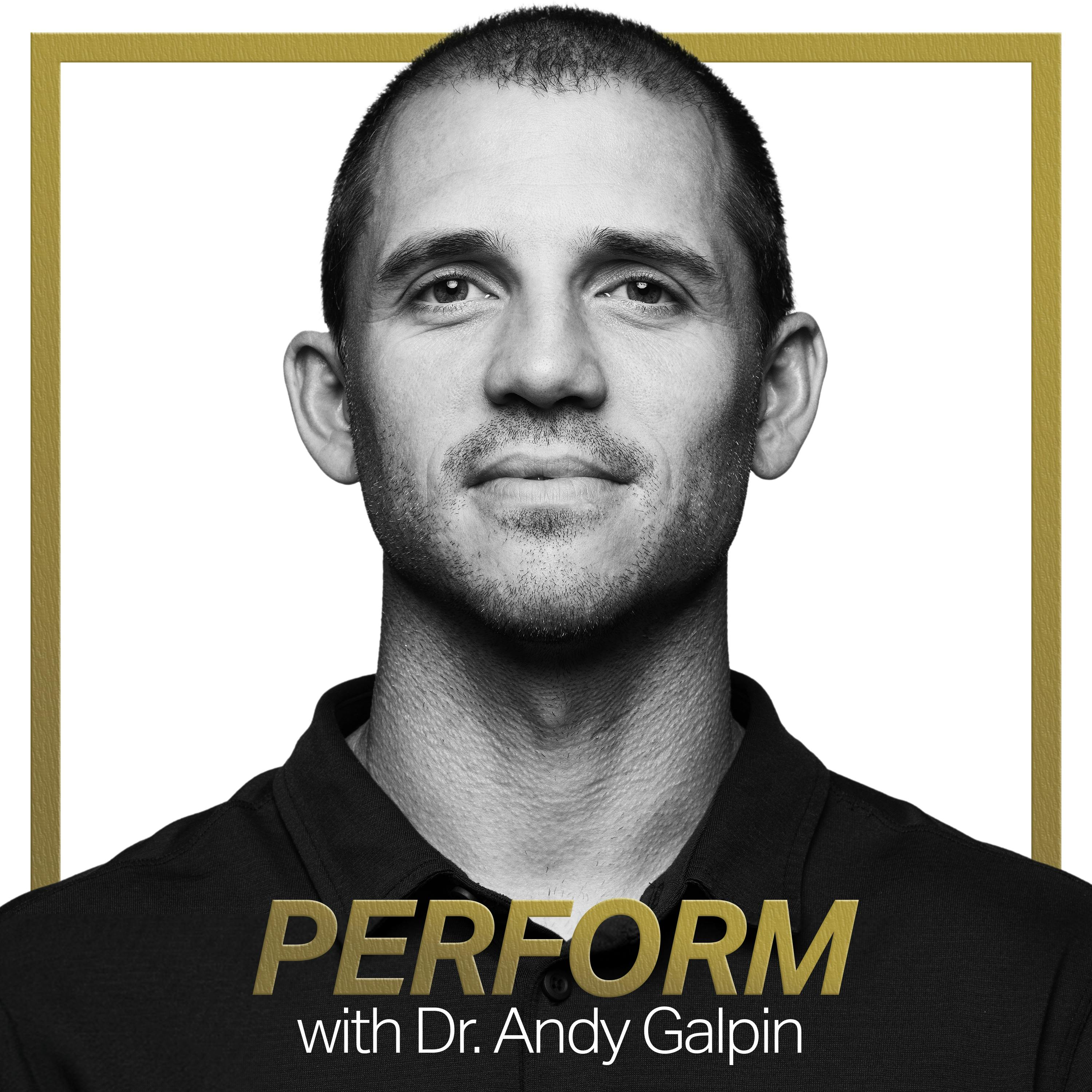
June 12, 2024 • 1hr 58min
How & Why to Strengthen Your Heart & Cardiovascular Fitness
Perform with Dr. Andy Galpin

Key Takeaways
- The importance of cardiovascular fitness goes far beyond just athletic performance - it is a critical factor in overall health, longevity, and quality of life
- VO2 max is one of the strongest predictors of all-cause mortality - studies show it is as predictive or more predictive than traditional risk factors like smoking, diabetes, and high blood pressure
- There appears to be no upper limit to the health benefits of increasing VO2 max - the higher it goes, the more it preserves against mortality risk
- Cardiac muscle has unique properties compared to skeletal muscle that allow it to contract continuously without fatigue or soreness
- The heart does not require nervous system activation to contract - it has its own intrinsic pacemaker system
- Breathing is primarily driven by CO2 levels, not oxygen levels - we feel the urge to breathe due to rising CO2, which affects blood pH
- Improving VO2 max requires training across a spectrum of intensities - from low intensity steady state to high intensity intervals
- Respiratory rate may be an underappreciated metric for assessing overall fitness and stress levels
- With proper training, it's realistic to expect a 30-50% improvement in VO2 max over 6-12 months for untrained individuals
Introduction
In this episode, Dr. Andy Galpin discusses the critical importance of cardiovascular fitness for overall health, longevity, and athletic performance. He explains the physiology of the heart, how it differs from skeletal muscle, and why metrics like VO2 max are so predictive of mortality risk. Dr. Galpin also covers practical ways to assess and improve cardiovascular fitness using what he calls the "Three I's" - Investigate, Interpret, and Intervene.
Topics Discussed
The Importance of Cardiovascular Fitness (00:08:47)
Dr. Galpin begins by discussing how he initially underappreciated the importance of cardiovascular fitness early in his career, focusing more on anaerobic performance. He then explains how landmark studies in the late 1980s and early 1990s showed that VO2 max was one of the strongest predictors of all-cause mortality:
- A 1989 study by Steven Blair in JAMA showed that low fitness levels increased mortality risk by 3-4x compared to high fitness
- More recent studies with over 750,000 participants have confirmed these findings
- VO2 max appears to be as predictive or more predictive of mortality than traditional risk factors like smoking, diabetes, and hypertension
- There seems to be no upper limit to the benefits - the higher VO2 max goes, the more it protects against mortality risk
"If I haven't convinced you of the importance of your VO2 max, I don't think I can."
Unique Properties of Cardiac Muscle (00:28:55)
Dr. Galpin explains how cardiac muscle differs from skeletal muscle in several key ways:
- Cardiac muscle fibers are much shorter and have only one nucleus per cell
- They are connected via intercalated discs that allow electrical signals to spread between cells
- Cardiac muscle does not fatigue or get sore like skeletal muscle
- It contracts continuously without requiring nervous system activation
"The heart does not require any nervous system activation to contract."
Heart Rate and Stroke Volume (00:53:25)
Dr. Galpin discusses how the heart adapts to exercise:
- Resting heart rate decreases as fitness improves, but maximum heart rate does not change significantly
- Stroke volume (amount of blood pumped per beat) increases with training
- Elite athletes can have resting heart rates in the 30s-40s beats per minute
- The lowest recorded resting heart rate was 28 bpm in cyclist Miguel Indurain
Why We Breathe (01:05:47)
Dr. Galpin explains that breathing is primarily driven by CO2 levels, not oxygen levels:
- Rising CO2 in the blood affects pH, which triggers the urge to breathe
- We can function anaerobically for some time, but CO2 buildup forces us to breathe
- Inhaling increases sympathetic activation, while exhaling increases parasympathetic activation
"You don't feel that air hunger or that desire to breathe because oxygen starts getting low...Increases in CO2 will do that."
Investigating Cardiovascular Fitness (01:14:01)
Dr. Galpin discusses ways to assess cardiovascular fitness:
- Resting heart rate can be measured manually or with wearable devices
- VO2 max is best measured in a lab, but can be estimated with field tests
- Heart rate variability (HRV) and respiratory rate are also valuable metrics
- Respiratory rate may be an underappreciated metric for assessing overall fitness and stress
Interpreting VO2 Max Scores (01:22:09)
Dr. Galpin provides context for interpreting VO2 max scores:
- Average untrained person: 35-45 ml/kg/min
- Below 18 ml/kg/min for men or 15-16 for women indicates difficulty living independently
- Elite level for 40-49 year old women: >47 ml/kg/min
- Elite level for men: >50 ml/kg/min
- Dr. Galpin's rule of thumb: "No excuse to be under 50 unless you're over 50"
Highest Recorded VO2 Max Scores (01:29:38)
Dr. Galpin discusses the highest VO2 max scores ever recorded:
- Bjørn Dæhlie (cross-country skier): 90.6 ml/kg/min
- Oskar Svendsen (cyclist): 96.7 ml/kg/min
- Paula Radcliffe (marathon runner): ~75 ml/kg/min
He provides context for how much blood these elite athletes can pump:
- Svendsen likely pumped ~12 gallons of blood per minute at max effort
- This equates to ~25-26 oz of blood pumped per second
Intervening to Improve VO2 Max (01:40:35)
Dr. Galpin explains how to improve VO2 max through training:
- Train across a spectrum of intensities:
- 70% low intensity (60-80% max heart rate)
- 20-25% moderate intensity (82-90% max heart rate)
- 3-6% high intensity (>92% max heart rate)
- Exercise mode (running, cycling, etc.) is less important than intensity
- Both steady-state and interval training can be effective
- High-intensity intervals can be very time-efficient but have more recovery costs
- With consistent training, 30-50% improvement in 6-12 months is realistic for untrained individuals
"I think you should do both [low and high intensity]. I will make the same argument for moderate intensity...it's reasonable to build some of that into your equation as well."
Conclusion
Dr. Galpin concludes by emphasizing the critical importance of cardiovascular fitness for overall health, longevity, and performance. He encourages listeners to assess their current fitness level using metrics like VO2 max, resting heart rate, and respiratory rate. By training across a spectrum of intensities and being consistent, significant improvements in cardiovascular fitness are achievable for most people. These improvements can have profound impacts on both athletic performance and long-term health outcomes.






